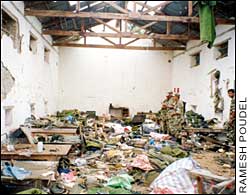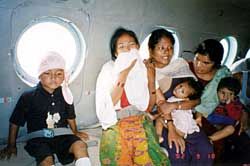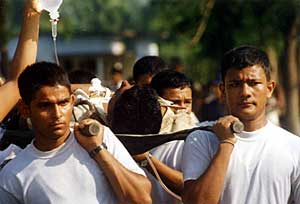Two days after the Sunday night Maoist raid at the district headquarters of Argakhanchi district, government buildings here are still smouldering. There is a pungent smell of rotting flesh mixed with the stench of burnt PVC pipes. Vultures circle overhead, looking for half-burnt corpses in the fields.
The 9,000 inhabitants of this picturesque central Nepal town are still in shock, and loiter nervously outside their homes. There are spent cartridges everywhere.
Don't walk too far out, there could be unexploded explosives and booby traps," a security official warned us. They are there to comb through the charred ruins, looking for more bodies hidden in the debris, and for mines. One had exploded earlier that day, injuring three soldiers.
Even Prime Minister Sher Bahadur Deuba had to hop over some unexploded ordnance as he toured the devastation Tuesday. He tried to reassure the locals that the Maoists would be defeated, but the locals wanted relief, which was not forthcoming. He told security officials: "We can't end terrorism overnight, but we'll do everything to make it easier for our security forces to fight them."
By Thursday morning, the death toll in Sandhikharka had crossed 110: 60 security forces personnel and two civilians, and 50 bodies of Maoists had been recovered. Among the dead was a 72-year-old woman who was shot in the stomach by Maoists who went house-to-house looking for hiding soldiers.
The Maoists deployed six platoons of hardcore fighters to ring Sandhikharka in a coordinated and meticulously planned attack. Some of the prisoners later freed by Maoists said the rebels admitted that their 'C' Platoon of 40 fighters had been decimated. The police station, the barracks and the armed police force base were attacked simultaneously. The rebels were supported by paramedics who had established nine field surgery tents outside the town with equipment and medicines looted from the district hospital. While the fighting raged, Maoist cadres were running back and forth carrying stretchers and resupplying fighters with fresh ammunition, and retrieving weapons from dead soldiers and fallen comrades.
"They spoke in code, I remember someone shouted 'Kalpana Long Range' and suddenly there was a burst of machine gun fire," a local resident told us. Even before the attack, Maoist support teams had already dug graves to bury their dead. They used cut-off dokos to ferry ammunition in, and the same ones to carry away their wounded and dead on the way out. For the first time, there is confirmation that senior Maoist leaders Krishna Bahadur Mahara, Nanda Kishor Pun (Pasang), Top Bahadur Rayamajhi, and Pampa Bhusal were leading the raid.
Independent sources discounted earlier reports that there were 4,000 Maoists. They said the actual number was closer to 1,500. "I haven't seen so many people even in the Chutre Besi Mela," a local resident told us. "They just sprung up out of nowhere." Most of the Maoist cadres were in their 20s, and bragged to their prisoners that the army's night-vision helicopters were "no match" for them. Learning from past battles, the Maoists appear to have set fire to vegetation and buildings, since smoke blinds the night-vision scopes on the helicopters.
The logistics and timing appear to have been carefully planned. A vehicle with unarmed Maoists defied a curfew to approach the town's checkpoint at 7PM, saying that they were delivering fish to the barracks. The main force arrived at around 10PM, and some of them were even shot at by sentries.
From the bullet casings and accounts of survivors, it is evident that the Maoists' main target was the army base, and that they deployed most of their firepower at the barracks. In addition to SLRs, machine guns and RPGs captured from the army, there are unconfirmed reports that the Maoists this time also had some AK-47s.
After the army base was overrun, the police fought hard until they, too, ran out of ammunition. There seems to have been some confusion between them about the chain of command. Also, the Maoists told the police that the army had already surrendered, and vice versa, sowing further doubt.
The army platoon at Sandhikharka had 54 soldiers, the police had 150 and the armed police about 30. Of them, 17 soldiers, 35 policemen, and nine paramilitary were killed. Of the 100 taken prisoner and forced to porter guns and ammunition looted from the barracks, 70 have since returned. The rest are believed to be straggling back to Pokhara in small groups, or dead.
Assistant CDO of Argakhanchi district Babu Ram Khatiwada was at home with his wife and three-year-old when the shooting began. "We thought we were safe because the army was there, and I thought the army was firing warning shots in the darkness as they often do," he told us. Soon, the Maoists were at his door. They handcuffed him and took him away with the others. Like the others, Khatiwada was forced to sign a document saying he would quit his job before being released.
The security forces guarding Sandhikharka seem to have been caught unawares. Sunday was the day when women had Teej feasts at home. Locals had noticed strangers passing through, but one shopkeeper told us: "The police and army didn't seem aware of what was going on."
The fighting went on till early Sunday morning. The Maoists were so confident that they even staged a victory parade before marching off with their captives who were made to carry the stolen weapons and Rs 90 million looted from the local bank. The telephones and electricity in the town have not been functioning, and all development activity has been at a standstill.
After a tour of the area, Brigadier General Prakash Bahadur Basnet from Pokhara admitted that this was a setback, but said that the army was capable of fighting on, provided there is adequate equipment. He told us: "It is critical also to have support from civil society, political parties, and the people." DIG of the western region, Kumar Koirala, agrees: "This war can be won, but we need adequate logistics and public support."

The barracks was housed in a Food Corporation godown, and is littered with the possessions of dead soldiers.

The wives and children of dead and abducted policemen being evacuated to Pokhara.

Policemen carrying a wounded comrade from the Bhiman battle Saturday.


